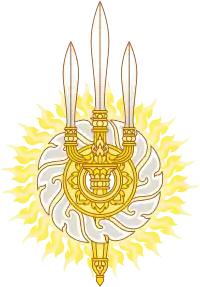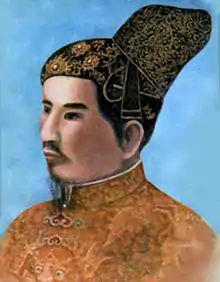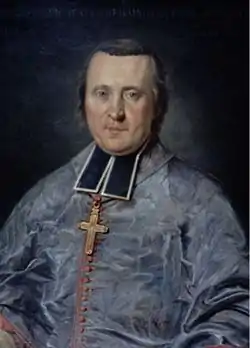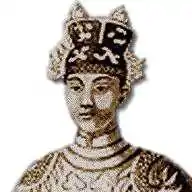Maha Sura Singhanat
Somdet Phra Bawornrajchao Maha Sura Singhanat (Thai: สมเด็จพระบวรราชเจ้ามหาสุรสิงหนาท; RTGS: Somdet Phra Boworaratchao Mahasurasinghanat, lit: His Royal Highness, Maharurasinghanat, Prince of Front Palace) (1744–1803) was the younger brother of Phutthayotfa Chulalok, the first monarch of the Chakri dynasty of Siam. As an Ayutthayan general, he fought alongside his brother in various campaigns against Burmese invaders and the local warlords. When his brother crowned himself as the king of Siam at Bangkok in 1781, he was appointed the Front Palace or Maha Uparaj, the title of the heir. During the reign of his brother, he was known for his important role in the campaigns against Bodawpaya of Burma.
| Maha Sura Singhanat มหาสุรสิงหนาท | |
|---|---|
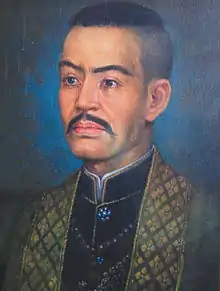 Painting of Maha Surasinghanat at Wat Chana Songkhram | |
| Viceroy of Siam | |
| Tenure | 1782 – 3 November 1803 |
| Appointed | Phutthayotfa Chulalok (Rama I) |
| Predecessor | Creation for the new dynasty, previously Krom Khun Inthraphithak |
| Successor | Isarasundhorn (later Rama II) |
| Deputy | Anurak Devesh |
| Born | 1 November 1744 Ayutthaya, Kingdom of Ayutthaya |
| Died | 3 November 1803 (aged 59) Bangkok, Siam |
| Spouse | Princess Sri Anocha (born Princess Rojja of Lampang) |
| Issue | 43 sons and daughters with various consorts |
| House | Chakri Dynasty |
| Father | Thongdi (later Somdet Phra Prathom Borom Maha Rajchanok) |
| Mother | Daoreung (Yok) |
Early life
Bunma was born in 1744 to Thongdee and Daoreung. His father Thongdee was the Royal Secretary of Northern Siam and Keeper of Royal Seal. As a son of aristocrat, he entered the palace and began his aristocratic life as a royal page. Thongdee was a descendant of Kosa Pan, the leader of Siamese mission to France in the seventeenth century. Bunma had four other siblings and two other half-siblings. Bunma himself was the youngest born to Daoreung.
Campaigns against the Burmese
In 1767, Ayutthaya was about to fall. Bunma fled the city with a small carrack to join the rest of his family at Amphawa, Samut Songkram. His brother the Luang Yokbat of Ratchaburi suggested that he should join Taksin's forces at Chonburi.
After the fall of Ayutthaya, the city and peripheral areas were under the control of the Burmese, while local Siamese nobles established their own states. In 1768, Taksin recaptured Ayutthaya and repelled the Burmese. After the establishment of Thonburi and coronation of Taksin, Bunma was appointed Phra Maha Montri (Royal Police of the Right).
In the same year the two brothers joined the forces against Lord Pimai of Korat. After the campaign he was raised to Phraya Anuchitraja Anuchitraja waged several fightings to repel Burmese invasions. In 1770, after the defeat of Lord Fang, Anuchitraja became Chao Phraya Surasi - the ruler of Pitsanulok and defender of northern frontiers. In 1771, Surasi joined Phraya Pichai in his legendary fighting that broke his sword. Chao Phraya Surasi was known for his ruthlessness in wars that the Burmese gave him the epithet Tiger Lord.[1] In 1774, Phraya Surasi and his brother was assigned the mission of the capture of Lanna from the Burmese. With the help of Prince Kawila of Lampang, the Siamese forces were able to take Chiangmai. Surasi then took Kawila's sister, Sri Anocha, as his principal wife.
During 1771 - 1781, Surasi joined his brother in massive campaigns subjugating the Laotian kingdoms of Vientiane, Luang Prabang, and Champasak, and Cambodia. In 1781, Taksin fell ill and a rebellion sprang out to depose the king. His brother the Somdet Chao Phraya Maha Kshatriyaseuk returned to Bangkok to undo the rebellion. Maha Kshatriyaseuk then crowned himself as Phutthayotfa Chulalok and moved the capital to the left bank of Chao Phraya river - modern Bangkok. Surasi, as Phutthayotfa Chulalok's right hand, was appointed the Front Palace or heir to the throne.
The Front Palace
Maha Sura Singhanat pioneered the construction of the Front Palace. In 1785, the Burmese king Bodawpaya launched the massive invasions of Siam in the Nine Armies War. Maha Sura Singhanat led the Siamese forces to receive the Burmese attacks coming from the west and south. He strategically defeated the superior Burmese armies and forced Bodawpaya to retreat. Next year in 1786, Bodawpaya came again and encamped his armies at Ta Din Daeng. Maha Sura Singhanat then inflicted the fatal blow to the Burmese and forced them to retreat for the second time.[2]
In 1802, the Burmese invaded Chiangmai. Phutthayotfa Chulalok sent his brother to relieve the siege on Chiangmai. However, Maha Sura Singhanat fell ill on the course of journey but dispatched his troops to Chiangmai in substitution. Phutthayotfa Chulalok, upon hearing about the illness of his brother, then sent his nephew Anurak Devesh the Rear Palace to get Chiangmai. But the Front Palace forces took Chiangmai beforehand and complained Royal Palace forces' inefficiency.[3] This stirred the conflicts between militarymen of the two palaces.
Death
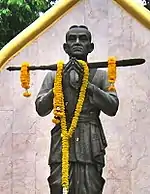
In 1803, Maha Sura Singhanat fell ill seriously. However, as recorded by Princess Kampushchat, Maha Sura Singhanat's daughter with his Cambodian concubine, the Front Palace officials blocked the Royal Palace forces from entering the Front Palace as Phutthayotfa Chulalok came to take care of his brother.[4] Maha Sura Singhanat also expressed his will that the treasures of the Front Palace should be inherited only by his own descendants. Maha Sura Singhanat finally died in 1803.
References
| Wikimedia Commons has media related to Maha Surasinghanat. |
- http://www.bloggang.com/mainblog.php?id=rattanakosin225&month=19-09-2007&group=1&gblog=34
- "Archived copy". Archived from the original on 2009-02-28. Retrieved 2014-01-07.CS1 maint: archived copy as title (link)
- "Archived copy". Archived from the original on 2009-06-16. Retrieved 2009-04-25.CS1 maint: archived copy as title (link)
- "Archived copy". Archived from the original on 2009-06-16. Retrieved 2009-04-25.CS1 maint: archived copy as title (link)
Maha Sura Singhanat Born: 1744 Died: 1803 | ||
| Preceded by Inthraphithak of Thonburi Kingdom |
Viceroy of Siam 1781–1803 |
Succeeded by Isarasundhorn |
